Content marketing has always been a rollercoaster ride. New tactics rise and fall, and Google’s endless updates add the twists and turns.
But right now… it feels different. Something fundamental has changed.
The tried-and-tested playbooks aren’t working as they used to. Boardrooms are determined to automate everything with AI.
And marketing departments are under pressure. As a percentage of company spending, marketing budgets have declined to 10.1%, down from 13.8% in 2022.
Such headwinds might make you think twice about crafting a new content strategy. But actually, rethinking your entire approach is a smart way to address the new realities of content.
This guide is designed to walk you through crafting a content strategy that will both stand up to internal scrutiny and deliver results that hit wider business goals.
I’ll warn you now: It’s going to take plenty of work and some deep thinking.
But trust me, it’s worth it.
Why You Need a Formalized Content Strategy
Why are you doing content marketing?
It might seem like a strange question to ask. But many companies skip this critical moment of self-reflection.
They dive into content marketing simply because a competitor is seeing success. “If it’s working for them, we should be doing it too!“
This often leads to what we call the “blog and pray” approach — pumping out content and waiting for something to happen.Unfortunately, that something rarely comes.
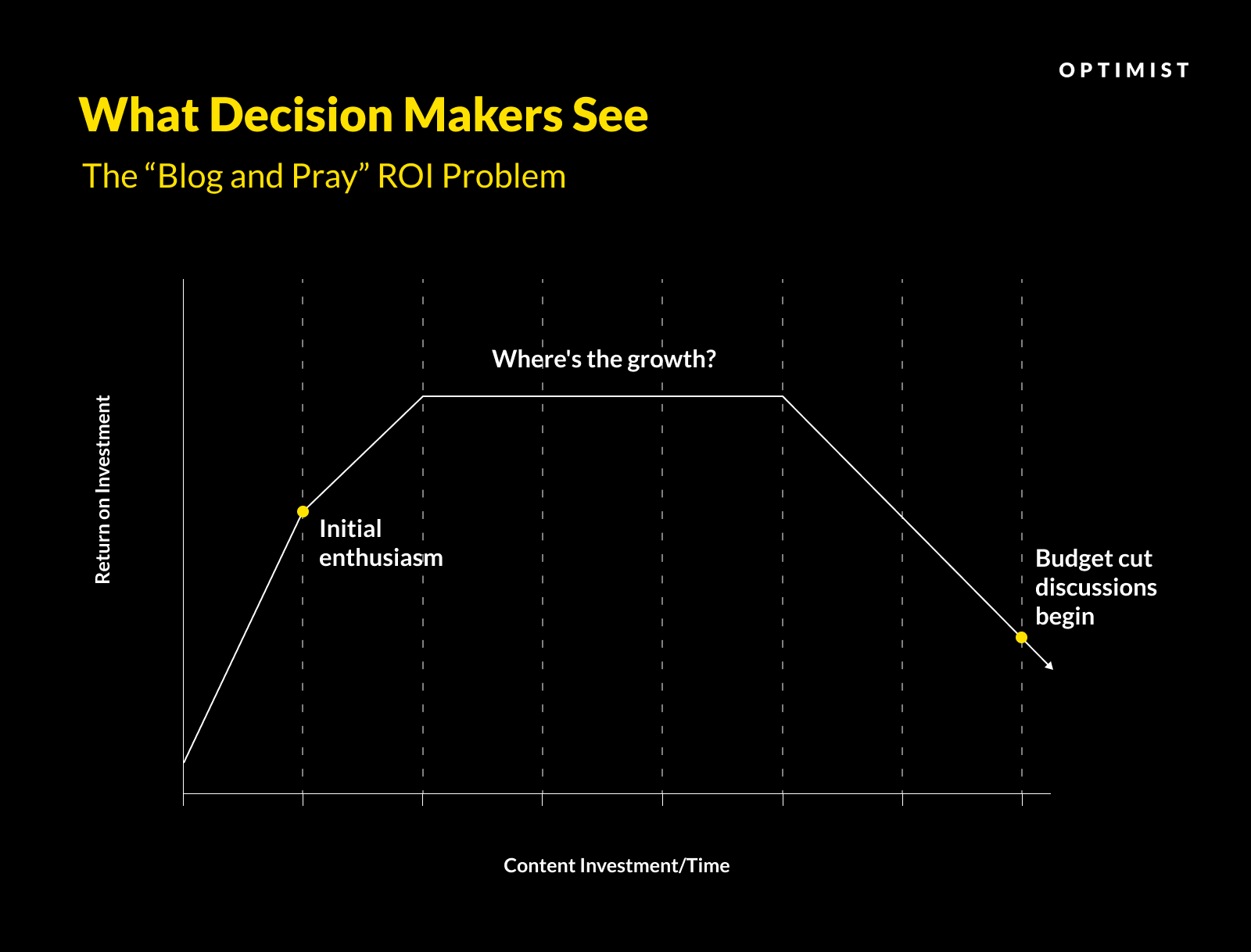
The fallout can be ugly. Instead of altering their approach, key stakeholders lose faith in the idea of content marketing altogether. Budget cuts loom.
Marketers often get swept along in the tide. We accept the initial enthusiasm for content marketing from our superiors without diving deeper into the why. And then we’re left to pick up the debris.
How do you avoid being washed up like this? By having a rock-solid strategy in place.
The Purpose of Your Content Marketing Strategy
As a marketer, your content strategy serves several functions.
First, it’s your mission statement. It should declare what you’re trying to achieve and how you plan to do it.
Second, your strategy is your map. It should provide clear directions, helping you find your way toward your stated goals. Whenever you need to make a tactical decision, the strategy will keep you properly oriented.
Third, your strategy is your business plan. When you need to bid for funding and navigate internal politics, it’s vital to have documentary evidence to back up your claims. It gives you a seat at the table; you’re no longer the backseat passenger who has no say.
To cover all these bases in one document, you need to create something that is specific, detailed, and clear.
Strategy vs. Plan
It’s important to note that your content marketing strategy is not the same thing as your content marketing plan.
This might seem pedantic. But it’s not.
Here’s the difference:
- Your strategy is the overarching vision of your content marketing efforts.
- Your plan contains the individual steps you’ll be taking to build that vision.
Your strategy is what informs your plan. That includes deciding which ideas you’re not going to pursue. Without a strategy, you end up creating a pile of blog posts with no clear direction or purpose.
Another point of difference is complexity. A good content strategy can be summarized with a single sentence. For example:
“We will grow our organic traffic by building a comprehensive library of keyword-optimized content.”
The more you add, the less focused your strategy will be.
In contrast, a plan needs to specify exactly how you will execute your strategy. And that means adding much more detail.
In this guide, we will look at planning (e.g., how to come up with specific content ideas) — but only after we have gone through all of the underlying steps to define the why, who, and how of our strategy.
The Many Layers of Content Marketing Strategy
Every good content marketing strategy starts with a problem.
I’m not talking about mistakes or design flaws here. I’m referring to a business problem.
You see, content marketing is a tool for fixing specific marketing challenges that are holding you back.
As you build your strategy, it’s important to identify the problems that you want to address.
You can then create goals that guide you toward fixing those problems.
To hit those goals, you’ll have to develop individual strategies.
And to apply those strategies, you need to select appropriate marketing channels for delivering your content.
Then, based on the channels you choose, you’ll need to decide your on-the-ground tactics.
Zoomed out, the workflow looks like this:

Note that the final framework won’t be so linear. In fact, it will look more like an org chart.
To solve each problem, you’ll need to create one or more goals. To hit these objectives, you may need several strategies, each relying on multiple tactics.
In other words, you need to attack each problem at increasing levels of detail.
The end result should be a constellation of finely tuned strategies, channels, and tactics, rather than a catch-all playbook.
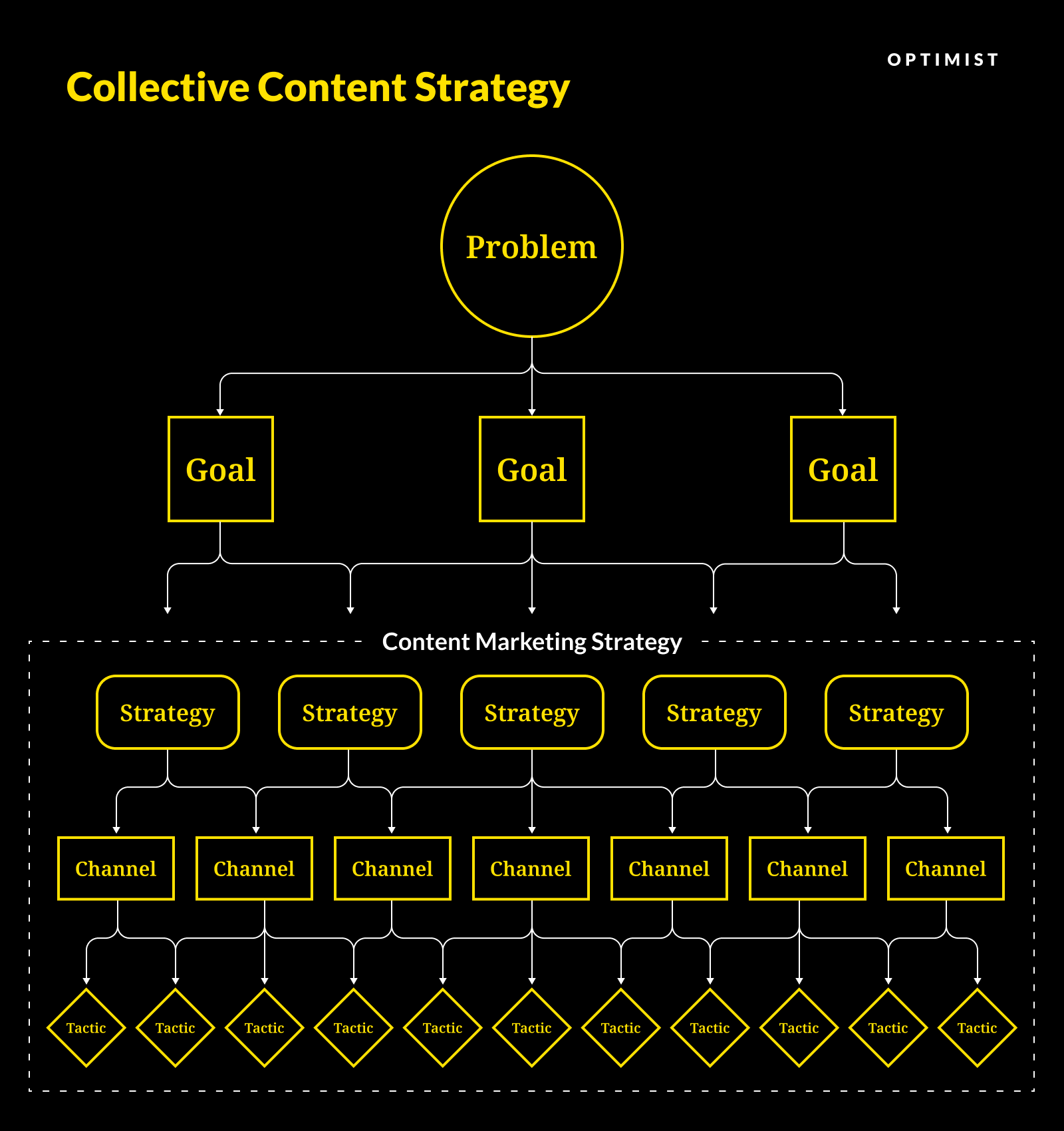
This reflects the reality of modern content marketing: your “strategy” is actually multiple individual strategies under one roof.
Stages of the Funnel
Looking at the chart above, we can see where content strategy fits into the family tree of decision-making.
But how do you apply this idea to the funnel?
Ideally, the problems you identify should be specific to the individual stages of the funnel.
Perhaps at the top of the funnel (what we call the Exploration stage), your main challenge is brand recognition.
Here, you might create a goal related to website traffic or mentions on social media. You would then shape your content strategies and select your tactics with these objectives in mind.
The same principle applies in the middle (Consideration) and bottom (Decision) stages of the funnel. It even applies pre-funnel (Affinity) and post-funnel (Retention).
Each stage will call for different strategies.
Different Content Types
There is one more layer to consider here: Content function.
Not all content performs the same function. Branded content is made to raise awareness. Lead gen is designed to drive conversions. SEO helps you to reach new customers.
Here are the five main functions that your strategy is likely to support:
- Brand: Builds awareness, shapes perception, and establishes trust and authority around your company and values.
- Demand Gen: Educates and engages potential customers early in their journey, sparking interest and creating a desire for your solutions.
- Lead Gen: Captures contact information from interested prospects in exchange for valuable resources, moving them further down the sales funnel.
- SEO: Optimizes your online presence to rank higher in search engine results, driving organic traffic and increasing discoverability.
- Lifecycle: Nurtures customers throughout their entire relationship with your brand, from initial awareness to post-purchase engagement and advocacy.
As you build strategies for each stage of the funnel, it’s important to consider these varying roles and think about how they can complement one another.
Putting It All Together
As you can see, modern content strategy is a multi-dimensional game.
You’re not constructing one overarching strategy; you’re really compiling a set of individual strategies to solve various challenges.
To help you fit together the many pieces of this jigsaw puzzle, we’ve devised a little something we call the Content Strategy Canvas.
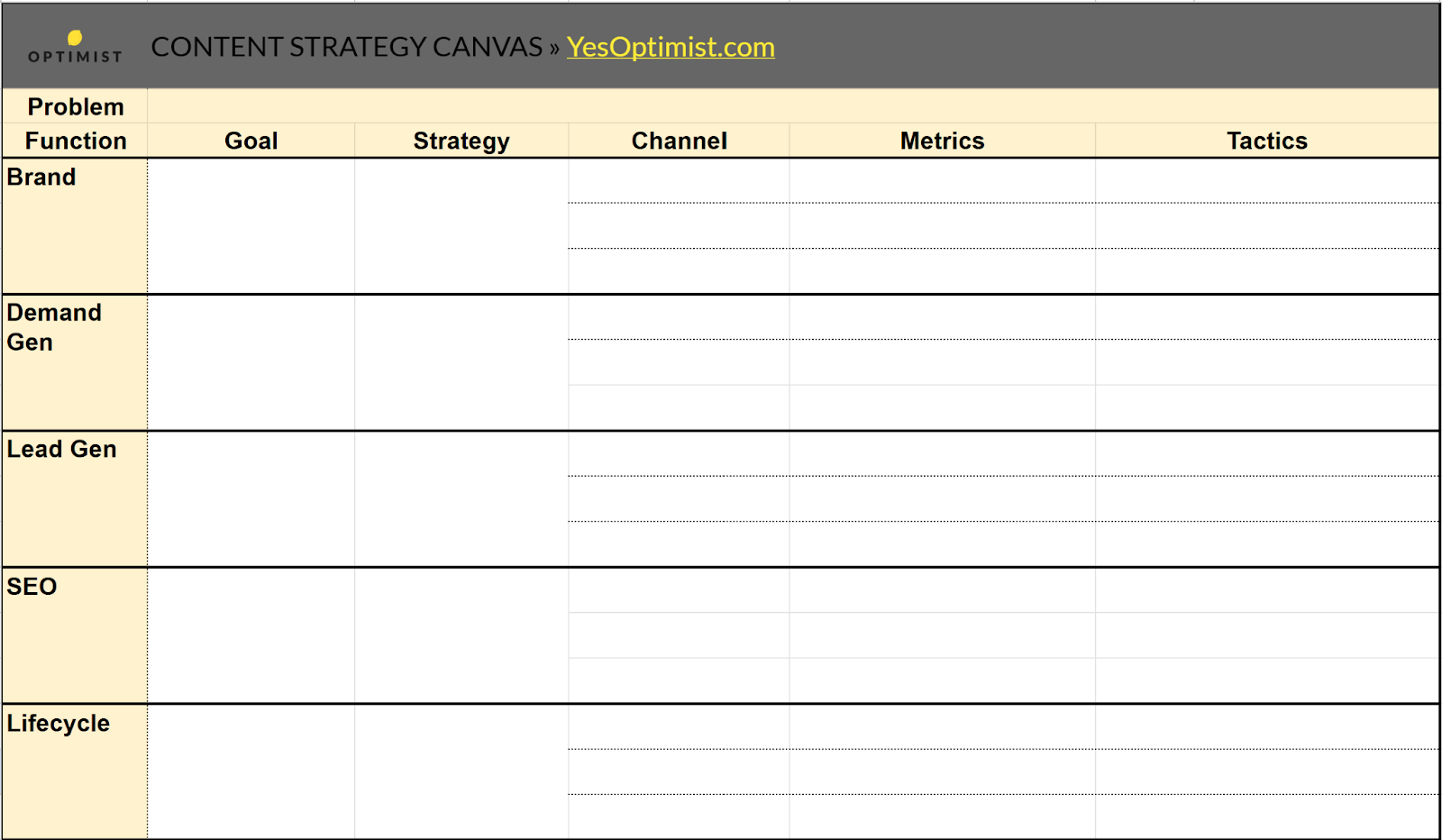
The Canvas is essentially a workbook. It provides a framework for organizing our problems, goals, strategies, and tactics at each stage of the funnel, along with various content types.
I would recommend making a copy of the Canvas and filling it out as we walk through building your strategy. That’s what we do at Optimist.
Once your Canvas is complete, it will become a reference document. The framework allows you to see all the moving parts while maintaining a high-level overview of your content strategy. Pretty neat, huh?
Identifying the Problems You Need to Solve
Enough with the theory. It’s time for action.
The first step in building your content strategy is to identify problems you want to address.
Hopefully, you already have some idea of what you want to fix here. Consider which areas of your marketing funnel are underperforming, and where content could help.
If possible, focus on the problems associated with a specific ICP (ideal customer profile). This will make it easier to identify appropriate solutions as you fill out the Strategy Canvas.
Let’s work through some examples.
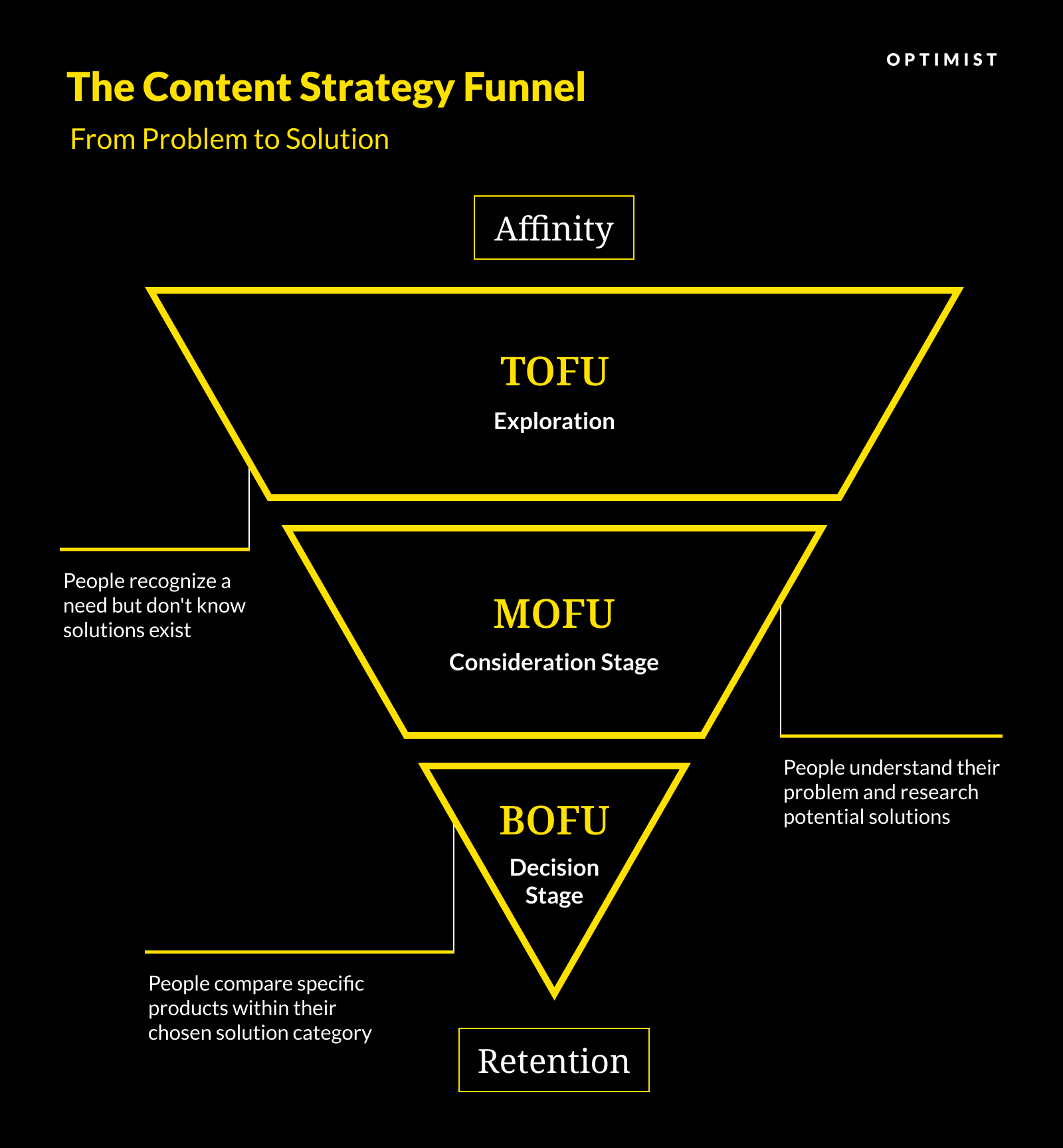
Example: Pre-Funnel Problem (Affinity Stage)
Imagine you’re the Head of Marketing for a software company. Your product is an AI-powered analytics platform for payroll, aimed at organizations with 500 employees or more.
Many larger HR and finance departments are quite resistant to change. Managers are aware of the flaws in everyday processes, but they don’t want to rock the boat. As such, they are not actively looking for new solutions.
Before you can start promoting your product, you need to lay the groundwork.
The pre-funnel problem here is:
“HR and finance leaders don’t recognize the inefficiencies our product can help address.”
Example: TOFU (Exploration) Problem
Just because your target audience is now aware of payroll analytics doesn’t mean they’re going to land on your solution.
The top of the funnel (aka the Exploration stage) is a competitive place. To turn curiosity into conversions, you need to be seen early.
The TOFU problem here is:
“Decision makers are not aware of our brand and the specific solutions we offer.”
Notice that this problem hits several key requirements:
- It can be addressed with content.
- It’s specific to one stage of the funnel.
- It provides a clear, quantifiable target to aim for.
- It’s a problem you can tackle from multiple angles, using a mix of content types.
If you study the following examples, you should see a similar pattern.
Example: MOFU Problem (Consideration Stage)
In B2B marketing, one of the biggest hurdles in the Consideration stage (MOFU) is internal friction.
Individuals within your target organization might discover your solution and like what they see — but they can’t see how to sell the idea to their superiors and coworkers.
In this case, the problem is:
“Individuals at target organizations don’t have the resources they need to feel confident selling our solution internally.”
Example: BOFU Problem (Decision Stage)
For our BOFU example, let’s assume everything is going well.
Plenty of enterprise HR and finance leaders now know about your brand and what you offer. They are engaged, have internal buy-in, and are ready to make a purchasing decision.
But implementing a new payroll system is a significant investment and potential risk. These leaders need a little extra reassurance that your platform will integrate seamlessly with their existing systems and deliver the promised efficiency gains.
At this stage of the funnel, your problem might be:
“Prospects don’t have enough information to decide if our AI payroll solution is the right choice for their enterprise needs.”
Example: Post-Funnel Problem (Retention Stage)
Now that you’ve successfully onboarded customers to your AI-powered payroll analytics platform, a new challenge emerges: ensuring they fully realize the ongoing value, and (ideally) expand their usage.
You notice that some customers only use the basic features of your platform, missing out on advanced capabilities that would deliver even greater ROI.
The retention problem here is:
“Customers don’t fully understand how to get the most value from our product.”
Defining Your Goals
Being able to name and describe your problems isn’t the same as knowing how to solve them. That’s why the next step in our process is goal setting.
The purpose of this step is really to identify what success would look like.
By setting clear objectives, you make it possible to measure your progress toward solving your problem.
At the same time, you create a path of stepping stones that leads toward your ideal destination — a useful mental model I like to use when goal setting.
Mapping Goals to Content Functions
Take another look at the Content Strategy Canvas. You’ll notice there’s space for a goal next to every major content function.
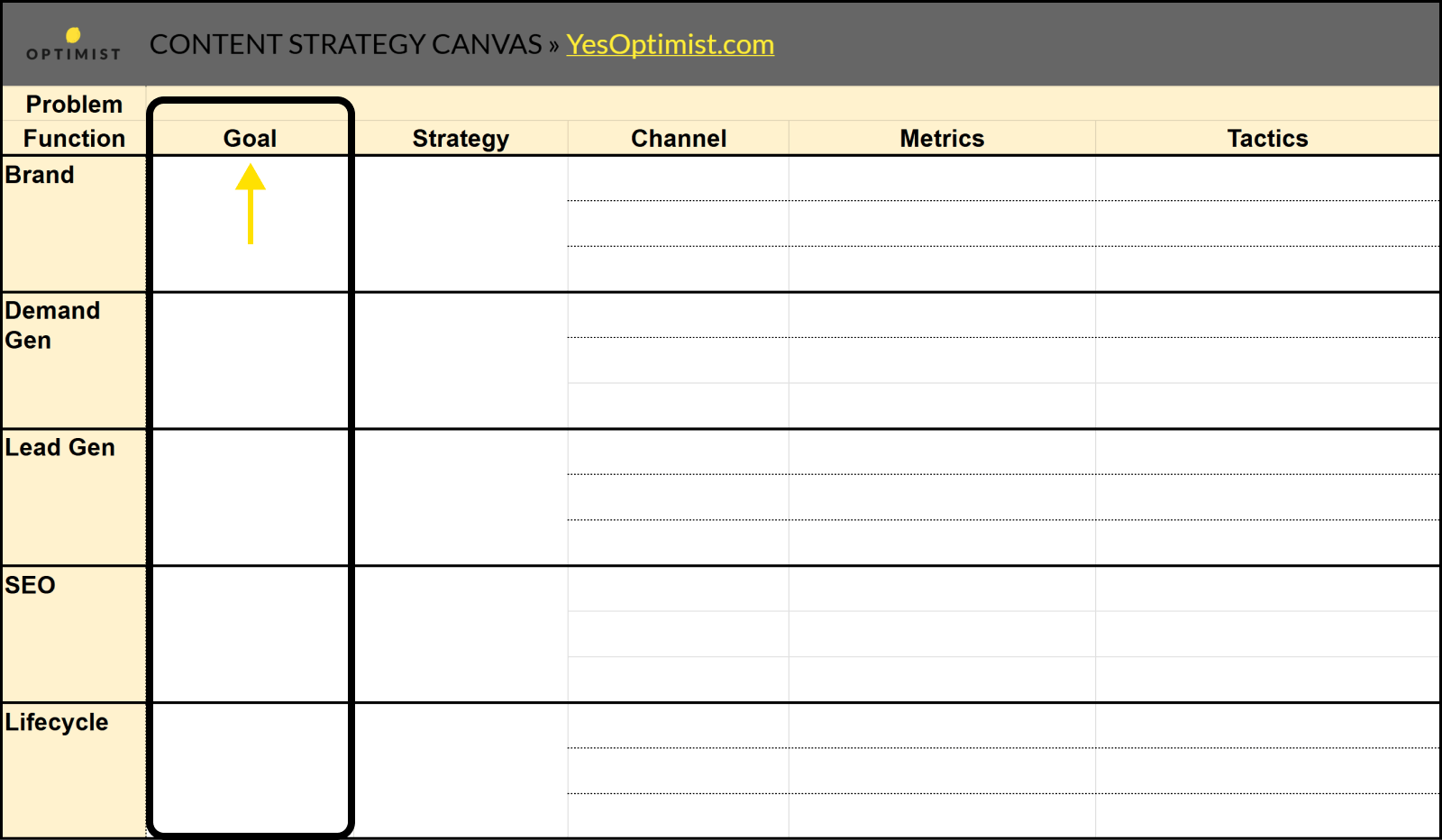
You don’t have to use every box. But it’s worth thinking about how different content categories could contribute toward solving your headline problem.
Say your challenge is that you’re not reaching the full spectrum of your target audience. You could consider the following goals:
- Brand: Increase social following for branded accounts and personal leadership profiles.
- Demand Gen: Increase visits to your homepage.
- Lifecycle: Get existing clients to consume more of your content and voluntarily recommend it to others.
You now have three clear goals. They all tackle very different parts of the problem. And individually, they wouldn’t solve the issue.
But if you hit all those objectives, you should be well on the way to better exposure.
Setting SMART Goals
When you’re filling out the goal sections of your worksheet, I would recommend following the SMART method.
You’ve probably come across this acronym before. As a recap, it stands for:
- Specific
- Measurable
- Achievable
- Relevant
- Time-bound
Let’s take a closer look at each of these attributes now.
Specific
Many marketers fall into the trap of creating vague goals.
It’s fine to talk about “boosting engagement” — but what does that really mean in practice? Again, we need to define what success would actually look like.
A more specific goal would be, “Attracting more comments on our Facebook posts.” This clearly shows what specifically you’re trying to achieve.
Measurable
Notice that the last example is specific but not measurable.
Setting goals with a quantifiable target is really important. The only way to know which of your strategies is working is by measuring the results. And that’s also how you can prove to your boss that it’s worth continuing with your plan.
So, a better goal would be, “Attracting 10% more comments on our Facebook posts.”
Achievable
Some people say that you should aim for the stars, and then be happy when you land on the moon.
That’s a nice fairytale. But we’re in the business of reality.
When you set goals for your content strategy, make sure they are truly gettable. You might be tempted to aim high to impress the higher-ups, but that gamble is likely to deliver a bite later down the line.
If you’re starting from a very low base, setting a target of 10% more Facebook comments is definitely achievable with the right time budget.
Relevant
Now here’s the tricky one.
Remember the stepping stone analogy? You don’t have to lay out your stones in a perfectly straight line. You can take the scenic route. But ultimately, the path across the river should end at the other bank.
In other words, your content goals don’t have to address your marketing problem head-on. Each goal can provide a small contribution that nudges you in the right direction.
Just make sure that each goal you create is actually relevant to the problem at hand. We don’t need any side quests!
Time-Bound
When are you going to achieve your goals? Setting a clear time limit is a great way to maintain accountability.
As I mentioned earlier, the time aspect of your goal also affects achievability. Increasing the number of comments on your Facebook profile by 10% is achievable within one month, but you might struggle to hit this goal in 24 hours.
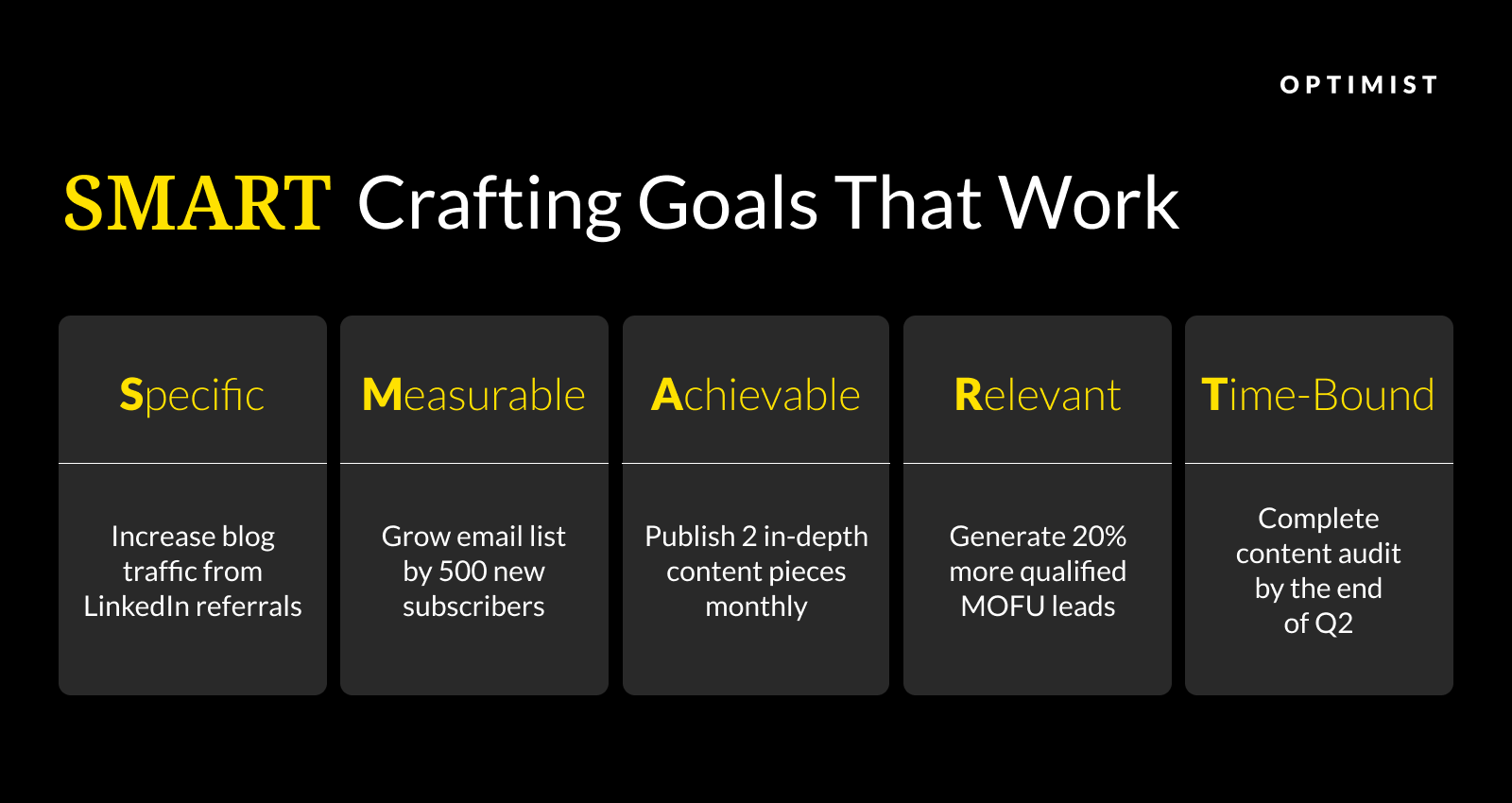
Selecting Your Strategies
You now know what you’re trying to achieve. How are you going to get there?
When you’re devising strategies, it’s helpful to think of yourself as an explorer.
Your problem is the starting point. Each goal is a destination.
How are you going to bridge the gap? The answer will be your strategy.
There’s a good chance you’ll need more than one strategy to solve each problem — not least because you may be aiming for multiple goals.
But each goal should be addressed with a single, custom-made strategy.
If you open the Strategy Canvas, you will notice there’s space for a strategy next to every goal.
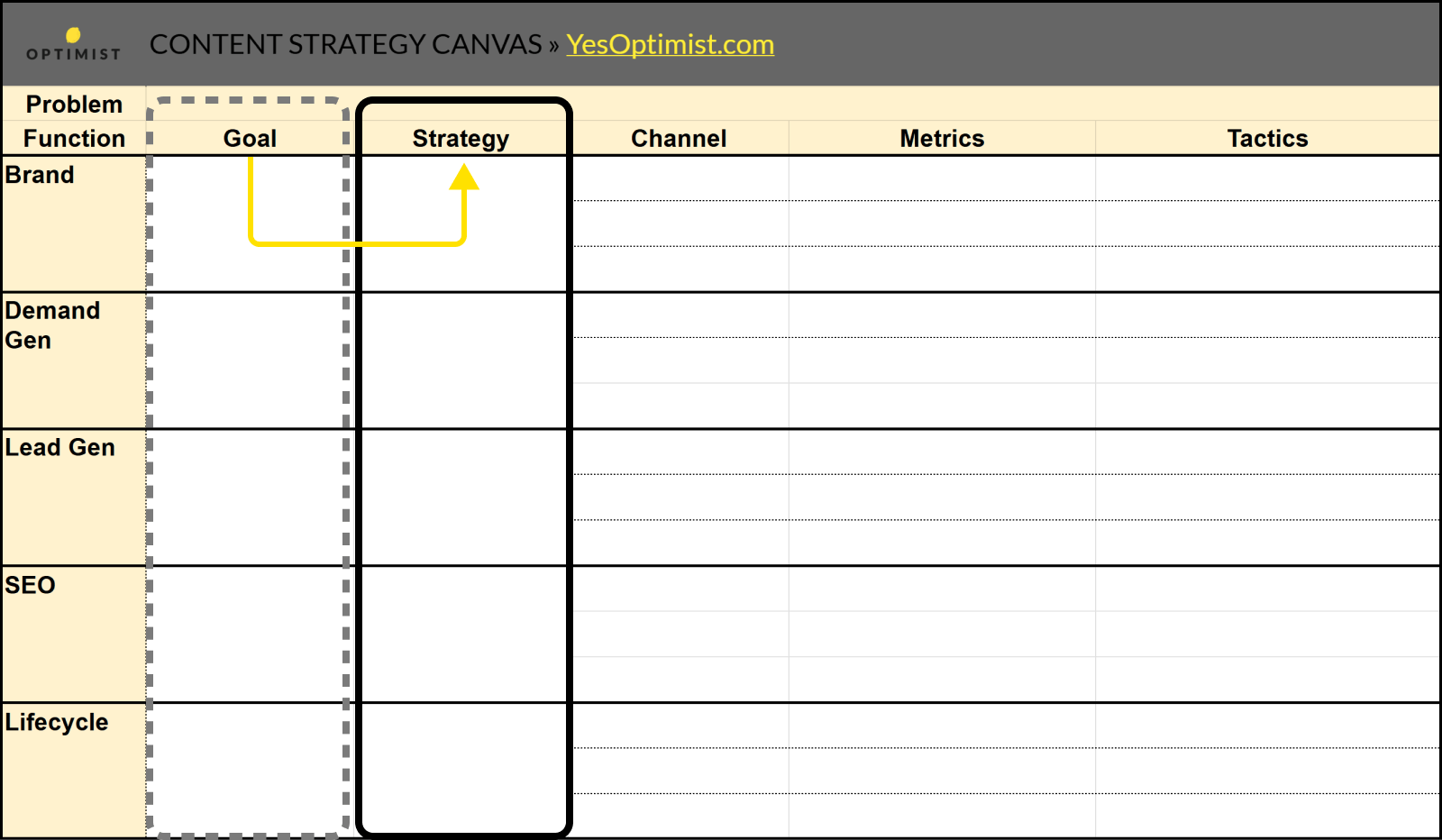
Needing multiple strategies is also a consequence of using multiple content functions and channels to address a specific challenge. Each path requires a different approach.
What do those paths look like? Let’s take a wander.
Roles, Goals, and Worries
The best content strategies don’t come from online templates. You won’t find them on X or even your favorite Slack group.
They actually come from your customers.
To be clear, I’m not expecting your paying clients to be content strategists. I’m talking about the insights you can pick up simply by listening to your customers and leads.
These people make up your target audience. And just like you, they have problems they want to solve. It could be a burning question. Maybe they’re looking for a good source of information. Or they could just be bored.
Whatever the issue might be, you can solve it with content. And that is what will attract people to your brand.
So, your starting point should be to understand the needs of your target readers.
Figuring this out might seem daunting at first, but we can break it down into smaller chunks.
Begin by selecting one of your ICPs. Then, try to identify three key attributes:
- Roles: Which hats does this person wear? That could mean different tasks they cover within a business, like the head of hiring and an HR helper. It could also mean the various roles in someone’s personal life, such as parent, head of DIY, and weekend golfer.
- Goals: What does this ICP want to achieve? Perhaps they’re trying to make life easier at work, earn more money, or buy a new car.
- Worries: What is standing between this ICP and their goals? Maybe they’re struggling to convince their boss that the department needs an IT upgrade. Perhaps they just don’t know where to start with a new purchase.
Not sure what to enter? You should get to know your customers a little better. Try running some surveys or setting up some conversations. You can always offer an incentive, like an Amazon voucher, in exchange for their time.
Building Strategies To Deliver Value
Once you have a clearer picture of what makes your customers tick, it becomes much easier to see how you can deliver value through content.
Say your main offer is business consulting for startup founders.
At the top of the funnel, your demand gen goal is to attract more homepage visits.
From your research, you know that your clients and leads are hungry for information. They’re desperately looking for real, actionable examples of startup success.
So, what’s your strategy going to be?
In this case, I would recommend a “building in public” content strategy. That is, publishing articles and social posts that peel back the curtain on your own business. It’s guaranteed to engage your target audience, and you can link to your homepage in every post.
Et voilà, you have your first strategy! Bridge construction complete.
Another Strategy Example
Consider a different ICP.
Perhaps your company has a SaaS product for the financial services industry. You’re reaching prospects with your TOFU content, and your MOFU content is converting them into genuine leads.
But you’re struggling to get deals across the line. Your leads are impressed, but they stick with big-brand competitors — even when those products seem like an imperfect fit.
Why? Jumping to a lesser-known solution feels like a risk. And they can’t find enough evidence to prove that making the leap is worthwhile.
You may conclude that SEO can help here. You set a goal of increasing the search visibility of your website for terms related to the decision-making process. If your brand appears more prominently, you might just earn the trust of those risk-averse leads.
How do you make a bigger impression in search?
In this case, I would suggest creating search-optimized articles that help readers evaluate and decide between different specific solutions in your niche.
By creating valuable content that directly addresses the needs of search users, you have an excellent chance of dominating Google. As a secondary benefit, your new content should give readers the confidence to choose your product.
The Importance of Goals
Coming up with content strategies is usually more about filling in the blanks than inventing something new… like a game of connect the dots.
When you put your business goals and the needs of your ICPs on the same piece of paper, it’s easy to see where the connecting line should be. Get it right, and you should end up with a neat picture.
This is a good moment to go back to the importance of goal setting.
If your goals don’t actually address the flaws in your marketing work, your strategy picture is going to deteriorate.
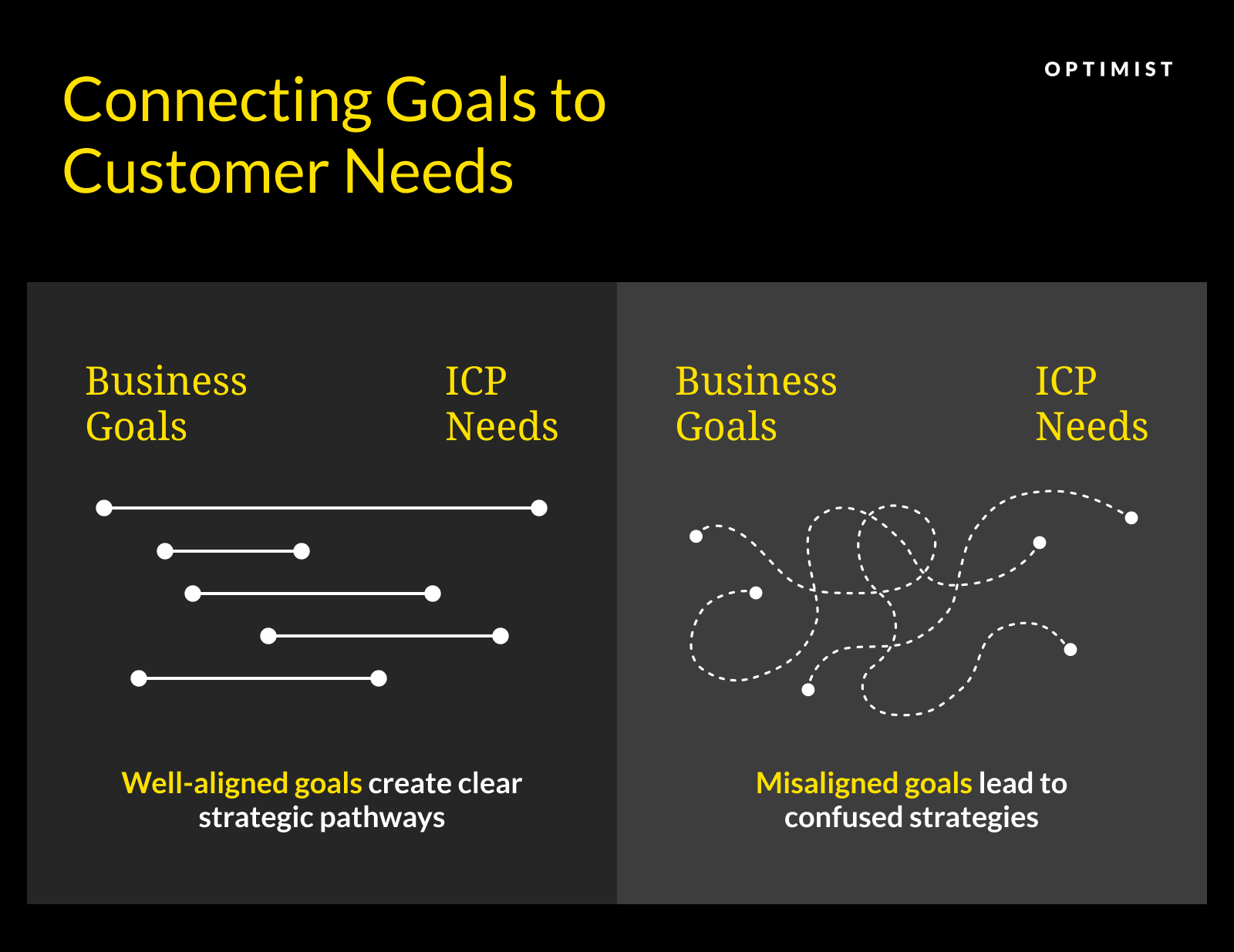
Basically, misguided goals are like dots in the wrong place. Yes, you’ll still be able to draw lines, but you’ll end up with an abstract mess.
So, before you start strategizing, make sure you’re aiming at the right target. If possible, include the insights from your ICPs at the goal-setting stage. It’s much easier to spend a little more time on setting goals than trying to fix your mistakes with creative strategies.
Choosing Your Channels
Good work! You’ve chosen strategies that perfectly align with your carefully chosen goals.
Now, you just need to figure out how to deliver.
Many marketers make the mistake of jumping straight into tactics at this juncture.
The tactics, however, come last in our workflow.The reason is simple: Channels dictate tactics.
There’s zero point in researching popular hashtags and fresh video content ideas if you’re going to launch an email marketing campaign. And even a world-class white paper is unlikely to impress anyone on TikTok.
You get the idea.
So, how do you choose which channels to target? Once again, your goals and your ICPs hold the answers.
Find Your ICPs, Then Add Your Goals
For any channel to be included in your overall content marketing strategy, it must be somewhere that your ICPs spend time.
A quick example to illustrate the point:
- If you’re selling gaming chairs, consider setting up a Reddit profile and creating a community on Discord.
- But creating content for LinkedIn will likely lead you nowhere
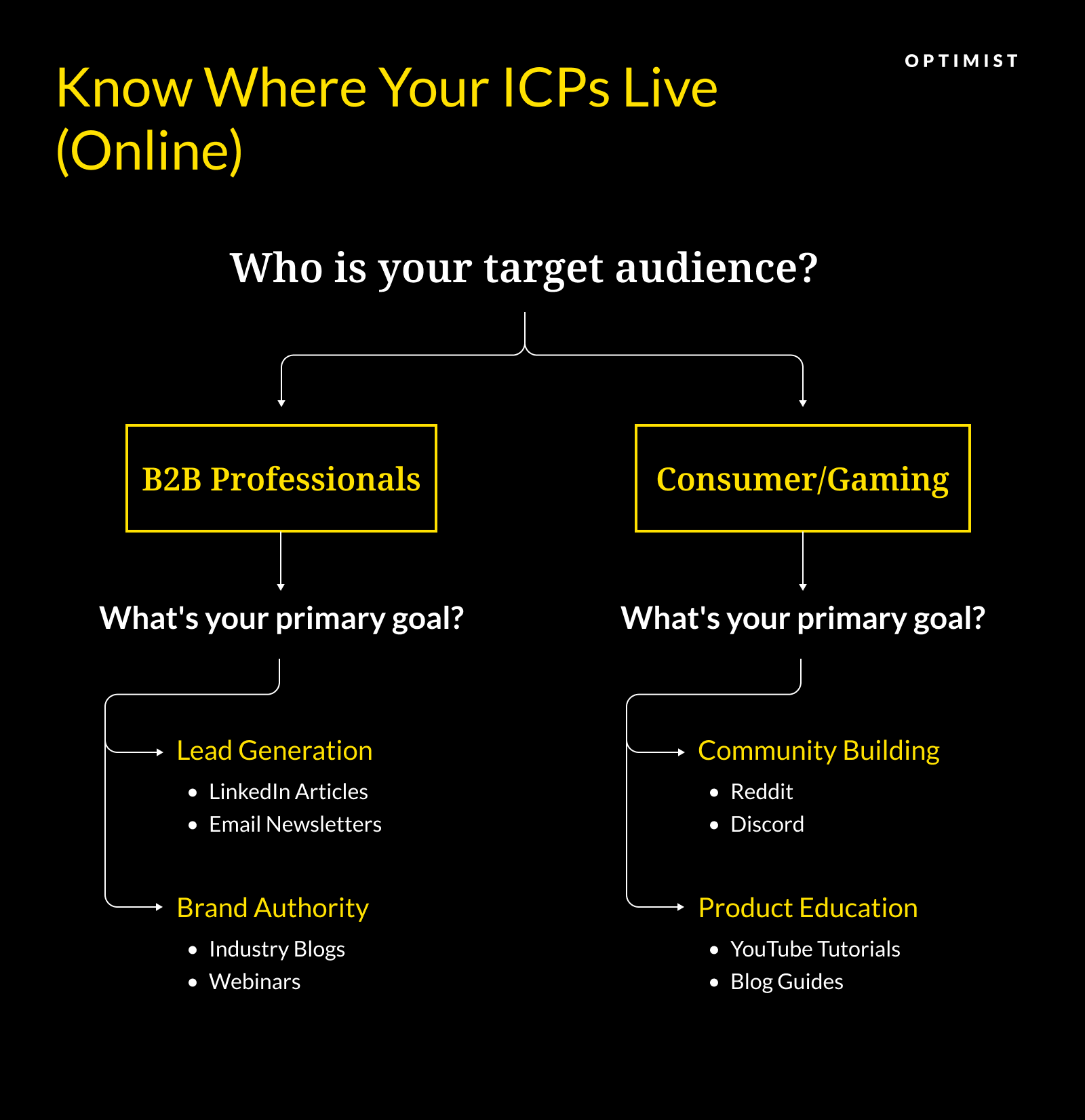
Once you’ve narrowed the field, start picking out the channels that work with your goal and strategy for your chosen type of content.
Returning to the gaming chairs for a minute:
- Posting a long-form buyers guide on Reddit or your blog to attract more leads to your website could work well.
- But no one is going to wade through 2,000 words on Discord. And they definitely won’t click your website link at the end of the message.
You might be picking up a theme here. Effective content strategy is about servicing the needs of your audience in a way that contributes to your own business goals.
Executing Your Strategy With Tactics and Metrics
At last, we’ve arrived at the final step. It’s time to put all the theory into practice.
Up until now, the strategy development process has been quite linear. One step informs the next, and so on.
But when you get to tactics, things get a little looser. This is your moment to be creative and consider all the possibilities.
Not sure where to start? Here are some proven techniques for establishing your tactical playbook.
What’s Already Working for You?
A good place to start is with your existing content.
Run a content audit to determine what’s working, what you can retire, and what you can repurpose.
For written content on your site, review your Analytics and Search Console reports to see what has drawn clicks over the last 1–2 years. Brainstorm ways to recreate or repurpose those hard-working posts. You can do the same for email newsletters and social content using the built-in analytics tools on your chosen platforms.
As you dissect your existing content, look for areas you can improve.
If there’s a blog post that earns loads of backlinks, is there a way to make it even more linkable by building an infographic? Is there content in the post you can repurpose on other platforms? Are you interlinking your most popular posts with new pieces of content to attract more search kudos?
Updating, recycling, and re-optimizing content that your audience loves is way easier than starting from scratch.
What Is Your Audience Looking For?
As with your strategy, your tactics should be led by the preferences of your ICPs.
Previously, we looked at the big picture — roles, goals, and worries. But to guide your tactical plan, you’ll need a much more detailed understanding of your audience.
That means knowing:
- Which posts they enjoy most.
- What time of day they’re likely to check your chosen channels.
- What kind of search terms they use.
- How they usually consume content.
- What actions they take after consuming a helpful piece of content.
You may be able to establish some facts using analytics, or through some good old-fashioned online sleuthing. Here’s one method our friend Daisy Quaker often uses:
- Fire up SparkToro to learn more about your target audience. Plug in your audience type (e.g., “digital marketing managers”) and get data on everything from whom they follow, to the websites they visit and amplify, down to which podcasts they listen to.
- Take that information and use a tool like BuzzSumo to get an idea of which topics perform well on the sites they visit, and apply that to your guest posting or blog strategy.

That said, it’s always worth asking your ICPs directly if you have the chance. A survey that takes just three minutes to complete can reveal a lot about your target audience.
Copy Your Competitors
Content marketing isn’t about reinventing the wheel. And there’s no copyright on strategies and tactics.
It’s totally okay to cherry-pick ideas from your competitors and adjust them to match your goals.
Figuring out what your competitors are doing well is surprisingly easy. Look at their content through the lens of search traffic and social traction, and see what they are promoting.
Then, brainstorm topics and content types that your competition hasn’t quite nailed.
You can even go head-to-head if you want. But unless you own the bigger brand, this approach usually just makes it harder to stand out. So, it’s generally better to take the best ideas and switch them up a little.
Participation as Content
We often think of content marketing in terms of traditional publishing. You share your content, and your audience consumes it.
But content isn’t a one-way street anymore. There’s often as much value in conversations as there is in content creation.
As you compile your tactics, include interaction in your content calendar. Comments and messages might seem like a waste of time, but a positive interaction could be as effective at driving interest as a well-made blog post.
Create a Content Marketing Plan
Remember when we looked at the difference between a content strategy and a content plan?
Well, now is the time to build a plan.
Having developed your tactics, you can start working on individual content ideas.
Sift, sort, and categorize these ideas into a working calendar, with due dates assigned to each piece.
Your editorial calendar should detail what you’ll be publishing and when. It should also provide an overview, making it easier to plan out your content strategically.
What is the goal for a particular piece? What promotion or outreach tactics will you be doing? Who is the audience?
Having all of this data in a single calendar view will help you maintain your strategic vision and prioritize work that needs to be done, based on the strategy that you’ve defined.
Measure Your Progress With Metrics
How do you tell whether your strategies and tactics are working? By measuring your progress.
Metrics can reveal whether your content marketing is helping you to achieve your business goals.
The link isn’t always direct. For example, you can’t possibly measure what effect content marketing alone is having on total sales. Equally, looking at content metrics (e.g., page views, time on site, etc.) alone won’t tell you anything about the business value you generate through content.
You need metrics that tie your tactics to your objectives. They should help you answer questions like, “Is this content actually creating value for our business?”
It’s important to choose your metrics wisely. They are likely to influence your actions as you execute your content marketing strategy.
Imagine you decide to monitor your bounce rate. There’s a good chance you will focus on tactics that get people from one page to the second page.
This may be valuable, but only if it actually contributes something toward your business goals.
Building Useful Metrics
To test this, you need to go beyond your basic metrics, like page views, and design something more specific.
For example, if your goal is to generate sales leads, then you will need metrics that tell you how well your content marketing specifically is helping to generate those leads.
It may look like this:
| Goal | Generate sales leads |
| Metrics | – Number of white paper/ebook downloads from the blog – “Contact us” inquiries generated from blog pages – Conversion rate for email subscribers |
Notice how we’ve taken the primary goal and broken it down into specific measurements that we can monitor every day, week, or month.
This makes it easier to determine if the results match your expectations.
Putting the Pieces Together
You’ve spent plenty of time building the individual components of your content strategy.
Now, it’s time to step back and admire your work.
Assuming you have completed the steps above, your Content Strategy Canvas should look something like this:
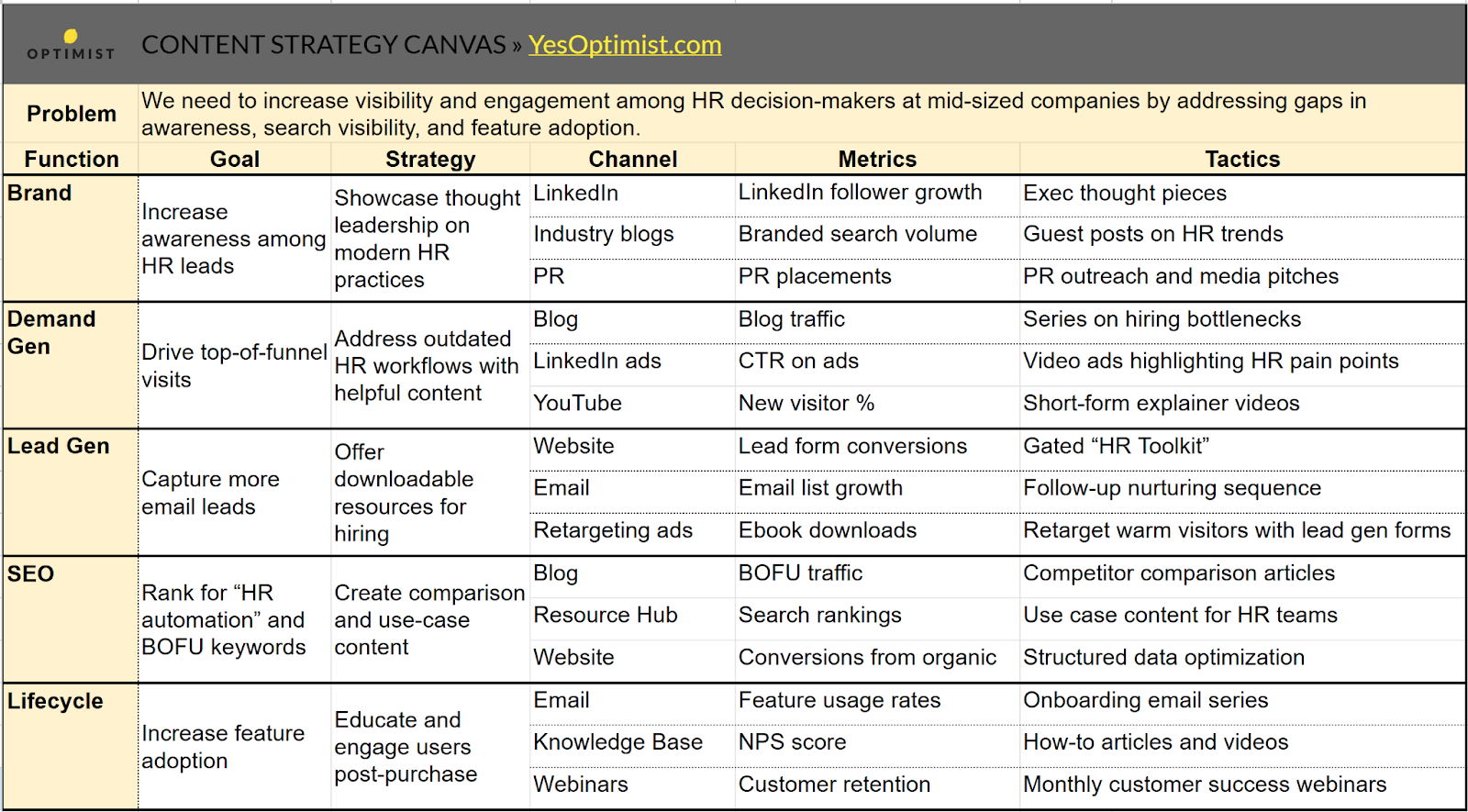
Here’s a reminder of the key components:
- Problem: Clearly states your task within this stage of the funnel.
- Goals: Aligned and SMART, each working toward solving your problem.
- Strategies: Crafted with your audience’s roles, goals, and worries in mind.
- Channels: Where your ICPs hang out, ensuring your content gets seen.
- Tactics and Metrics: The creative execution and the means to monitor success hand-in-hand.
Seeing the Strategy Canvas filled out helps you appreciate how deliberate each step was — nothing left to chance.
This same clarity will become your greatest asset when communicating your strategy internally or collaborating with your team.
The Perfect Content Marketing Strategy
If you’ve made it this far, you’re a real one. Content strategy is a pretty deep topic, and you can easily get lost in the murky waters.
As you’ve worked through this guide, I hope you’ve picked up some helpful tips on creating a content marketing strategy that will help your business grow.
Of course, I can’t fit every detail of the process into a single post. But the resources included throughout this guide are meant to fill in the gaps.
Refer to them to give you the tactical guidance you need to develop and execute your strategy.
Content strategy by Emily Bauer.
Visual direction by Katy Flatt.
Editing by Brinda Gulati.
Design by Anabelle Pang.
Content production by Rizky Darmawan.
Content help from Tyler Hakes.
Additional content by Daisy Quaker.